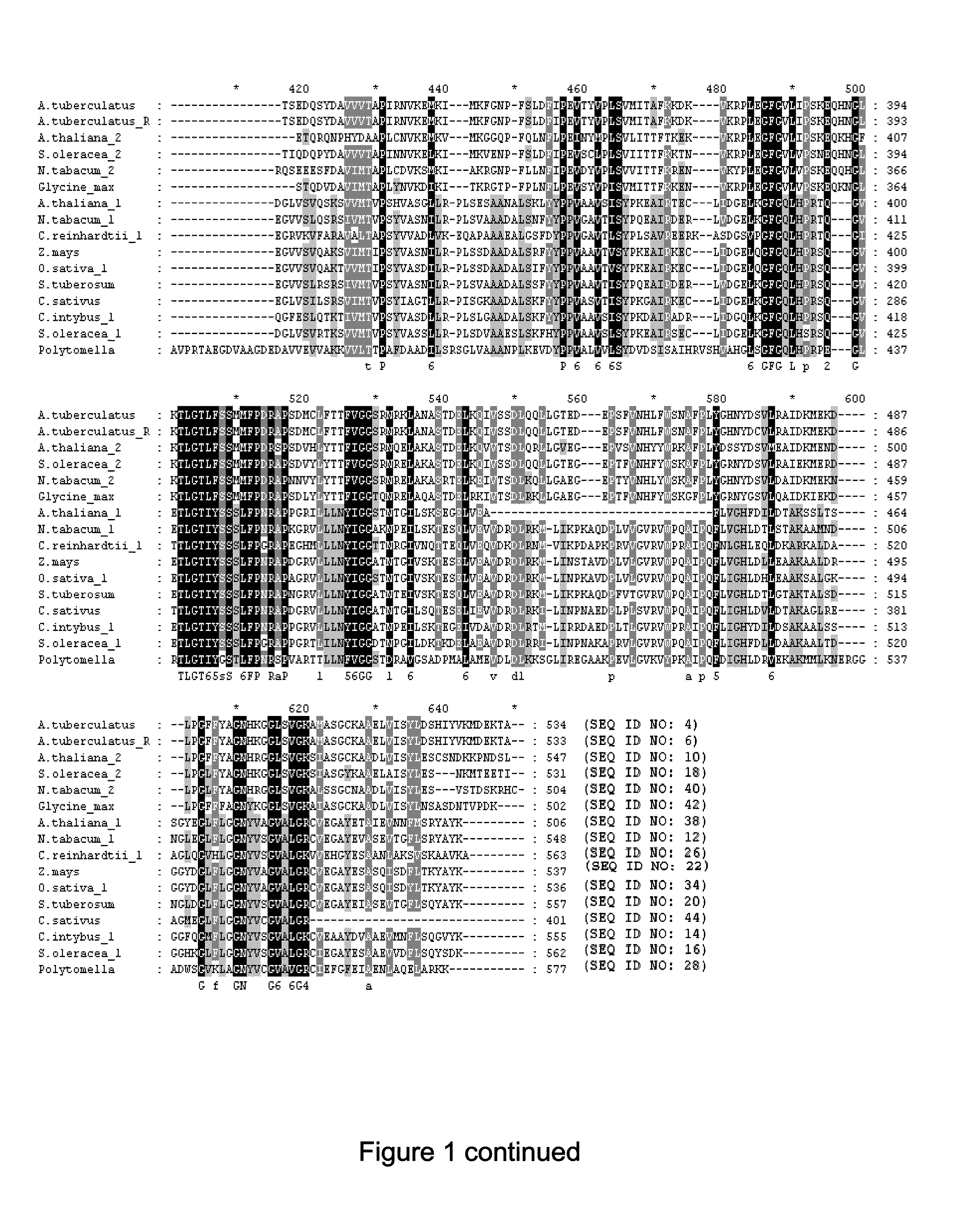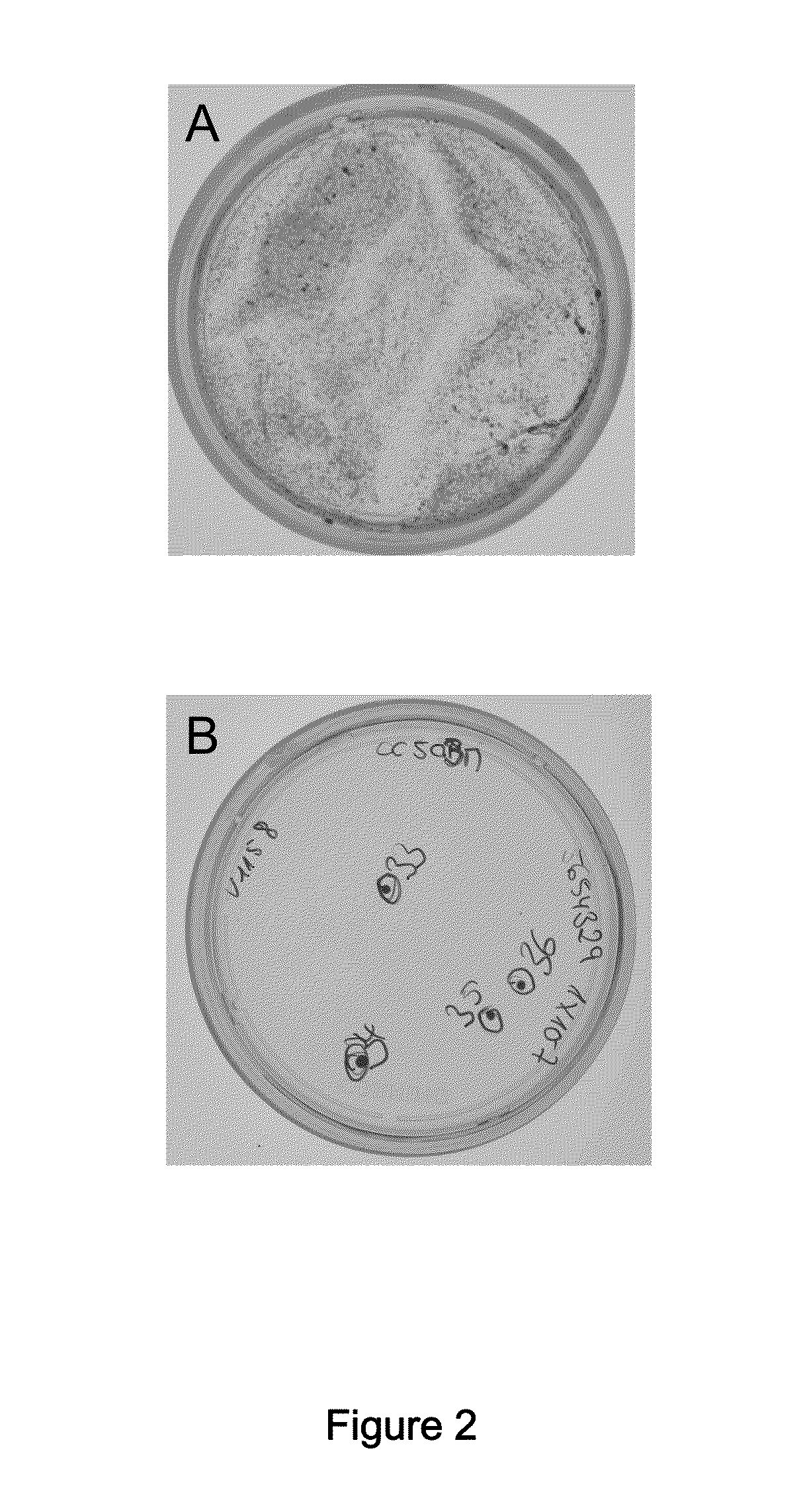Plants Having Increased Tolerance to Herbicides
a technology of plant tolerance and herbicide, which is applied in the direction of drug composition, enzymology, dna/rna fragmentation, etc., can solve the problems of rapid cell death, accumulation of protoporphyrinogen ix in chloroplasts and mitochondria, etc., and achieve the effect of increasing the resistance to benzoxazinone-derivative herbicid
- Summary
- Abstract
- Description
- Claims
- Application Information
AI Technical Summary
Benefits of technology
Problems solved by technology
Method used
Image
Examples
example 1
Site-Directed Mutagenesis of Amaranthus PPO
[0346]Cloning of Aramanthus PPO
[0347]The Amaranthus tuberculatus coding sequence for PPO-susceptible and -resistant isoforms, and mutant combinations, (SEQ ID No: 1, 3, 5, 7) were synthesized and cloned by Geneart (Geneart AG, Regensburg, Germany).
[0348]Plasmids were isolated from E. coli TOP10 by performing a plasmid minpreparation and confirmed by DNA sequencing.
[0349]Expression and Purification of Recombinant Wildtype and Mutant PPO
[0350](Taken from: Franck E. Dayan, Pankaj R. Daga, Stephen O. Duke, Ryan M. Lee, Patrick J. Tranel, Robert J. Doerksen. Biochemical and structural consequences of a glycine deletion in the α-8 helix of protoporphyrinogen oxidase. Biochimica et Biophysica Acta 1804 (2010), 1548-56)
[0351]Clones in pRSET vector were transformed into BL21(DE3)-pLysS strain of E. coli. Cells were grown in 250 mL of LB with 100 μg mL-1 of carbenicillin, shaking overnight at 37° C. Cultures were diluted in 1 L of LB with antibiotic ...
example 2
Screening of Mutagenized Algae Cells to Identify Herbicide Tolerant Clones and Causative Mutations in PPO Genes
[0358]To generate mutations conferring benzoxazinone-derivative herbicide resistance in PPO genes, chemical or UV mutagenesis can be used. Especially unicellular organisms like Chlamydomonas reinhardtii or Scenedesmus obliquus are useful for identifying dominant mutations in herbicide resistance.
[0359]Algae cells of Chlamydomonas reinhardtii strains CC-503 and CC-1691 (Duke University, Durham, USA) are propagated in TAP medium (Gorman and Levine (1965) PNAS 54: 1665-1669)
by constant shaking at 100 rpm, 22° C. and 30 μmol Phot*m−2*s−2 light illumination. Scenedesmus obliquus (University of Gottingen, Germany) are propagated in algae medium as described (Boger and Sandmann, (1993) In: Target assays for modern herbicides and 15 related phytotoxic compounds, Lewis Publishers) under same culturing conditions as mentioned for Chlamydomonas. Compound screening is performed at 450 ...
example 3
Screening of EMS Mutagenized Arabidopsis thaliana Population to Identify Herbicide Tolerant Plants and Identification of Causative Mutations in PPO Genes
[0364]A M2 population of EMS treated Arabidopsis thaliana plants are obtained from Lehle Seeds (Round Rock, Tex., USA). Screenings are done by plating Arabidopsis seeds on half-strength murashige skoog nutrient solution containing 0.5% gelating agent Gelrite® and a benzoxazinone-derivative herbicide (0.1 to 500 μM), depending on compound activity. Plates are incubated in a growth chamber in 16:8 h light:dark cycles at 22° C. for up to three weeks. Tolerant plants showing less intense bleaching phenotypes are planted in soil and grown to maturity under greenhouse conditions. In rosette plant stage, leaf discs are harvested from benzoxazinone-derivative herbicide tolerant plants for isolation of genomic DNA with DNeasy Plant Mini Kit (Qiagen, Hilden, Germany) or total mRNA with RNeasy Plant Mini Kit (Quagen, Hilden, Germany).
[0365]PPO...
PUM
| Property | Measurement | Unit |
|---|---|---|
| pH | aaaaa | aaaaa |
| pH | aaaaa | aaaaa |
| pH | aaaaa | aaaaa |
Abstract
Description
Claims
Application Information
 Login to View More
Login to View More - R&D
- Intellectual Property
- Life Sciences
- Materials
- Tech Scout
- Unparalleled Data Quality
- Higher Quality Content
- 60% Fewer Hallucinations
Browse by: Latest US Patents, China's latest patents, Technical Efficacy Thesaurus, Application Domain, Technology Topic, Popular Technical Reports.
© 2025 PatSnap. All rights reserved.Legal|Privacy policy|Modern Slavery Act Transparency Statement|Sitemap|About US| Contact US: help@patsnap.com



